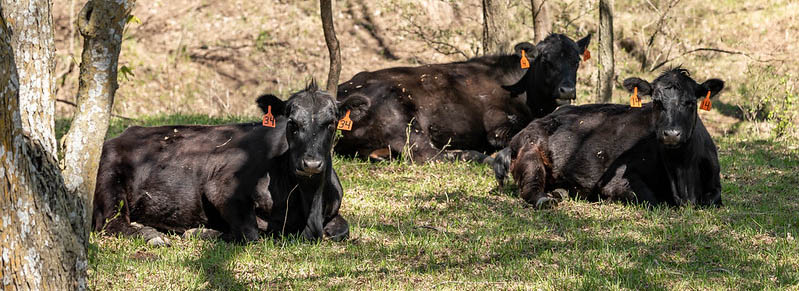
Cattle resting in the shade. | Download photo
Cattle Chat: How viruses move across species
K-State beef cattle veterinarians share their perspective on highly pathogenic avian influenza
At a glance: K-State Beef Cattle Institute experts explain highly pathogenic avian influenza and its ability to move to other species.
More information: Brian Lubbers, 785-532-4012, blubbers@vet.k-state.edu; Bob Larson, 785-532-4257, rlarson@vet.k-state.edu; Brad White, 785-532-4243, bwhite@vet.k-state.edu
Related: Beef Cattle Institute Cattle Chat
May 14, 2024
By Lisa Moser, K-State Research and Extension news service
MANHATTAN, Kan. – Anyone who remembers the COVID-19 pandemic may have a heightened sense of concern with news stories announcing that traces of the influenza virus have been appearing in unexpected places.
On a recent Cattle Chat podcast, Kansas State University veterinarians shared their educational insight to help beef producers get an understanding of how the highly pathogenic avian influenza virus transmits and what that might mean for cattle operations.
“(HPAI) is a virus. Most viruses don’t cross species, but the influenza virus is one that will move between birds and pigs, and occasionally other animals including humans,” K-State veterinarian Bob Larson said.
K-State veterinarian Brian Lubbers added: “It is called highly pathogenic avian virus because in birds there is a high mortality rate,” Lubbers said. “It often moves from wild birds that bring it through the flyways to commercial poultry operations and that can lead to a high death loss.”
Earlier this year, the virus was detected in dairy cattle operations.
“With this particular outbreak, we’ve seen it cross over to cattle, usually at low levels, and that is something we haven’t identified before,” Larson said.
So far, the dairy cattle have had a different experience with the HPAI virus compared to how a typical virus might impact them, Lubbers said.
“Usually, viruses in dairy cattle are more likely to impact cows in early lactation when there is some immunosuppression around the time of calving, but with this virus, it seems to be associated with cows in mid-lactation, with the primary clinical signs being high fever and decreased milk production,” he said.
The way that veterinarians can confirm the presence of the virus is through testing.
“Identifying the virus means that viral genetic material has been detected by a PCR test or a genome sequencing test,” Lubbers said.
K-State veterinarian Brad White added: “Many of these tests pick up on the genetic components, but that doesn’t necessarily mean there is a live virus in the animals or anything else that we test, such as milk or meat.”
So, what should a beef producer do with this information?
“Beef producers need to recognize that diseases are complex and it takes time to figure them out,” Larson said. “Right now, we still have a lot to learn about this virus in cattle.”
As part of that cautionary step, governmental agencies are putting restrictions on cattle movements.
“USDA APHIS has developed regulations regarding interstate movement of lactating dairy cattle, so it is important to work with your local veterinarian to get the latest information prior to shipping animals from the dairy,” Lubbers said.
He also advised producers to have a heightened awareness of what is happening on their operations.
“If you notice a large die-off of wild birds, that would be something to notify someone about,” Lubbers said. “Also, if your herd has some positive tests, it would be good to monitor the workers in the operation closely.”
To hear the full discussion, listen to Cattle Chat on your preferred streaming platform.
***

K‑State Research and Extension is a short name for the Kansas State University Agricultural Experiment Station and Cooperative Extension Service, a program designed to generate and distribute useful knowledge for the well‑being of Kansans. Supported by county, state, federal and private funds, the program has county extension offices, experiment fields, area extension offices and regional research centers statewide. Its headquarters is on the K‑State campus in Manhattan. For more information, visit www.ksre.ksu.edu. K-State Research and Extension is an equal opportunity provider and employer.